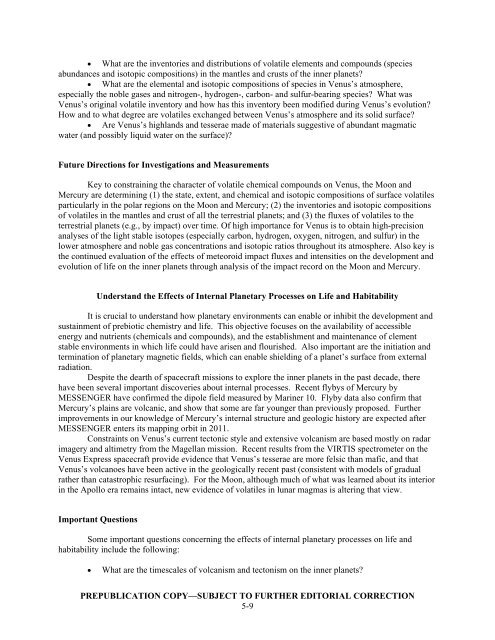Vision and Voyages for Planetary Science in the - Solar System ...
Vision and Voyages for Planetary Science in the - Solar System ...
Vision and Voyages for Planetary Science in the - Solar System ...
You also want an ePaper? Increase the reach of your titles
YUMPU automatically turns print PDFs into web optimized ePapers that Google loves.
• What are <strong>the</strong> <strong>in</strong>ventories <strong>and</strong> distributions of volatile elements <strong>and</strong> compounds (species<br />
abundances <strong>and</strong> isotopic compositions) <strong>in</strong> <strong>the</strong> mantles <strong>and</strong> crusts of <strong>the</strong> <strong>in</strong>ner planets?<br />
• What are <strong>the</strong> elemental <strong>and</strong> isotopic compositions of species <strong>in</strong> Venus’s atmosphere,<br />
especially <strong>the</strong> noble gases <strong>and</strong> nitrogen-, hydrogen-, carbon- <strong>and</strong> sulfur-bear<strong>in</strong>g species? What was<br />
Venus’s orig<strong>in</strong>al volatile <strong>in</strong>ventory <strong>and</strong> how has this <strong>in</strong>ventory been modified dur<strong>in</strong>g Venus’s evolution?<br />
How <strong>and</strong> to what degree are volatiles exchanged between Venus’s atmosphere <strong>and</strong> its solid surface?<br />
• Are Venus’s highl<strong>and</strong>s <strong>and</strong> tesserae made of materials suggestive of abundant magmatic<br />
water (<strong>and</strong> possibly liquid water on <strong>the</strong> surface)?<br />
Future Directions <strong>for</strong> Investigations <strong>and</strong> Measurements<br />
Key to constra<strong>in</strong><strong>in</strong>g <strong>the</strong> character of volatile chemical compounds on Venus, <strong>the</strong> Moon <strong>and</strong><br />
Mercury are determ<strong>in</strong><strong>in</strong>g (1) <strong>the</strong> state, extent, <strong>and</strong> chemical <strong>and</strong> isotopic compositions of surface volatiles<br />
particularly <strong>in</strong> <strong>the</strong> polar regions on <strong>the</strong> Moon <strong>and</strong> Mercury; (2) <strong>the</strong> <strong>in</strong>ventories <strong>and</strong> isotopic compositions<br />
of volatiles <strong>in</strong> <strong>the</strong> mantles <strong>and</strong> crust of all <strong>the</strong> terrestrial planets; <strong>and</strong> (3) <strong>the</strong> fluxes of volatiles to <strong>the</strong><br />
terrestrial planets (e.g., by impact) over time. Of high importance <strong>for</strong> Venus is to obta<strong>in</strong> high-precision<br />
analyses of <strong>the</strong> light stable isotopes (especially carbon, hydrogen, oxygen, nitrogen, <strong>and</strong> sulfur) <strong>in</strong> <strong>the</strong><br />
lower atmosphere <strong>and</strong> noble gas concentrations <strong>and</strong> isotopic ratios throughout its atmosphere. Also key is<br />
<strong>the</strong> cont<strong>in</strong>ued evaluation of <strong>the</strong> effects of meteoroid impact fluxes <strong>and</strong> <strong>in</strong>tensities on <strong>the</strong> development <strong>and</strong><br />
evolution of life on <strong>the</strong> <strong>in</strong>ner planets through analysis of <strong>the</strong> impact record on <strong>the</strong> Moon <strong>and</strong> Mercury.<br />
Underst<strong>and</strong> <strong>the</strong> Effects of Internal <strong>Planetary</strong> Processes on Life <strong>and</strong> Habitability<br />
It is crucial to underst<strong>and</strong> how planetary environments can enable or <strong>in</strong>hibit <strong>the</strong> development <strong>and</strong><br />
susta<strong>in</strong>ment of prebiotic chemistry <strong>and</strong> life. This objective focuses on <strong>the</strong> availability of accessible<br />
energy <strong>and</strong> nutrients (chemicals <strong>and</strong> compounds), <strong>and</strong> <strong>the</strong> establishment <strong>and</strong> ma<strong>in</strong>tenance of clement<br />
stable environments <strong>in</strong> which life could have arisen <strong>and</strong> flourished. Also important are <strong>the</strong> <strong>in</strong>itiation <strong>and</strong><br />
term<strong>in</strong>ation of planetary magnetic fields, which can enable shield<strong>in</strong>g of a planet’s surface from external<br />
radiation.<br />
Despite <strong>the</strong> dearth of spacecraft missions to explore <strong>the</strong> <strong>in</strong>ner planets <strong>in</strong> <strong>the</strong> past decade, <strong>the</strong>re<br />
have been several important discoveries about <strong>in</strong>ternal processes. Recent flybys of Mercury by<br />
MESSENGER have confirmed <strong>the</strong> dipole field measured by Mar<strong>in</strong>er 10. Flyby data also confirm that<br />
Mercury’s pla<strong>in</strong>s are volcanic, <strong>and</strong> show that some are far younger than previously proposed. Fur<strong>the</strong>r<br />
improvements <strong>in</strong> our knowledge of Mercury’s <strong>in</strong>ternal structure <strong>and</strong> geologic history are expected after<br />
MESSENGER enters its mapp<strong>in</strong>g orbit <strong>in</strong> 2011.<br />
Constra<strong>in</strong>ts on Venus’s current tectonic style <strong>and</strong> extensive volcanism are based mostly on radar<br />
imagery <strong>and</strong> altimetry from <strong>the</strong> Magellan mission. Recent results from <strong>the</strong> VIRTIS spectrometer on <strong>the</strong><br />
Venus Express spacecraft provide evidence that Venus’s tesserae are more felsic than mafic, <strong>and</strong> that<br />
Venus’s volcanoes have been active <strong>in</strong> <strong>the</strong> geologically recent past (consistent with models of gradual<br />
ra<strong>the</strong>r than catastrophic resurfac<strong>in</strong>g). For <strong>the</strong> Moon, although much of what was learned about its <strong>in</strong>terior<br />
<strong>in</strong> <strong>the</strong> Apollo era rema<strong>in</strong>s <strong>in</strong>tact, new evidence of volatiles <strong>in</strong> lunar magmas is alter<strong>in</strong>g that view.<br />
Important Questions<br />
Some important questions concern<strong>in</strong>g <strong>the</strong> effects of <strong>in</strong>ternal planetary processes on life <strong>and</strong><br />
habitability <strong>in</strong>clude <strong>the</strong> follow<strong>in</strong>g:<br />
• What are <strong>the</strong> timescales of volcanism <strong>and</strong> tectonism on <strong>the</strong> <strong>in</strong>ner planets?<br />
PREPUBLICATION COPY—SUBJECT TO FURTHER EDITORIAL CORRECTION<br />
5-9











